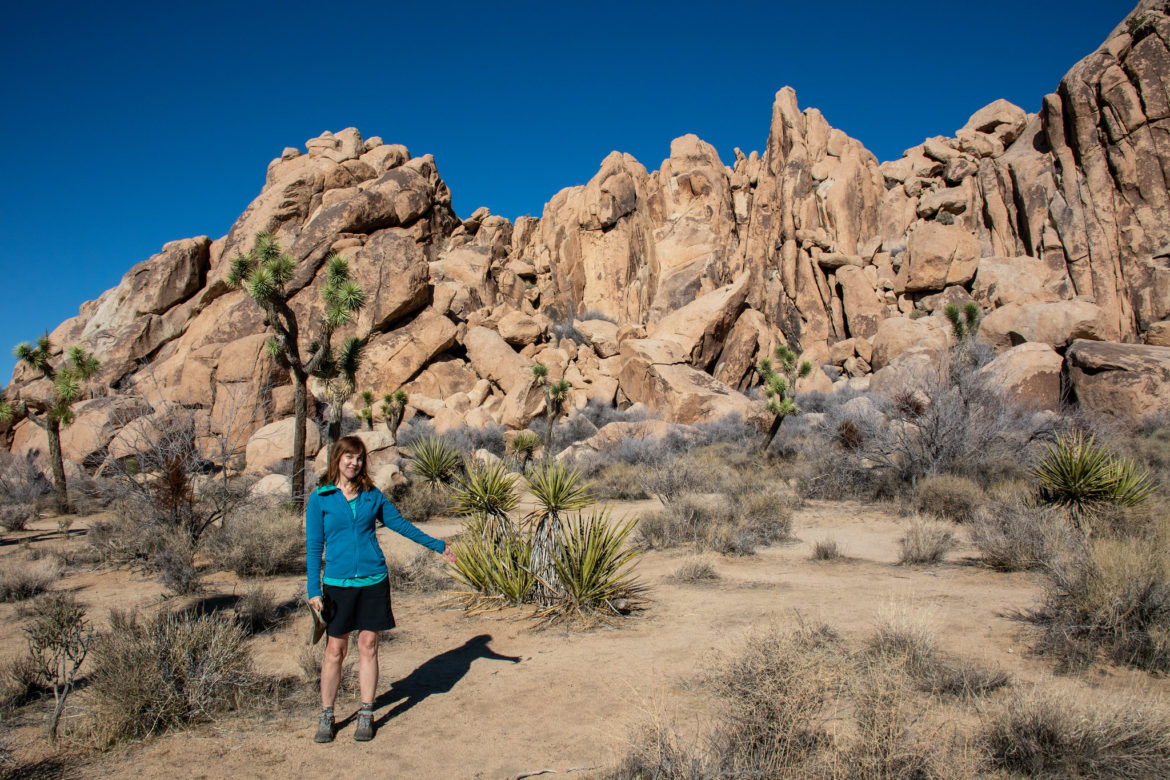The unique vibes of Joshua Tree National Park set it apart from other popular destinations. With its lunar-like landscape and Joshua Trees, visitors feel the sense of escaping to a mysterious wonderland. This park is one of the premier rock-climbing destinations in the world. Plus, with epic trails and desertscape, it’s also fantastic for hiking and camping. After visiting with my gal pals in January for 3 days, I love sharing this first-timer’s Joshua Tree National Park Guide.
“Of all the paths you take in life, make sure some of them are dirt.” – John Muir
First of all, this is not a stereotypical Chevy Chase Wally World destination. It attracts many climbers, hikers and outdoors people. Plus, the best time to visit is in Oct. – May, therefore, not attracting hordes of families with kids on summer break like Yellowstone or Yosemite. Overall, there is more of a laid-back feel with visitors that truly respect all the natural bounty this park offers.
What are Joshua Trees?
The Joshua Tree is actually not a tree. It is a species belonging to the Yucca genus and is the world’s largest Yucca. They only grow in the Mojave Desert of California, Utah, Arizona and Nevada. Furthermore, they grow best at 2,000 – 4,000 feet in elevation. Joshua Trees were named by the Mormon settlers in the 1800’s. They saw the tree’s branches pointing upward, resembling a bible story of Joshua praying.
Joshua Trees live about 500 years and bloom usually from March – April. They play a huge importance on the ecosystem of the Mojave Desert and are protected. Moreover, there are disheartening signs that Joshua Trees are endangered by climate change. Thus, in so many ways they are a beacon. So, tread lightly if visiting this treasure trove of a park.
Background and Flora/Fauna of Joshua Tree National Park
President Franklin D. Roosevelt proclaimed Joshua Tree National Monument in 1936. Later in 1996, as part of the California Desert Protection Act, it became a national park. This park protects 792,510 acres, where the Mojave and Colorado Deserts meet.
The western half of the park is the Mojave Desert, at elevations above 3,000 feet. Common flora abound here, such as, pinyon pines, junipers, scrub oaks, Mojave yuccas, Mojave prickly pear cacti and Joshua Trees. In comparison, the eastern half is the Colorado Desert lying less than 3,000 feet. Common flora here include the ocotillo, green-barked palo verde and patches of jumping cholla cactus.
The convergence of the Mojave and Colorado Deserts engenders a high biodiversity in flora and fauna. Wildlife in the park includes bighorn sheep, cactus wren, chuckwallas, roadrunners, gambel’s quail, hares, desert iguana, lizards, desert tortoise, rattlesnakes and scorpions.
Unique Rock Formations/Boulders
The gorgeous rock formations are stunning and display a surreal backdrop to the gnarled, spiky Joshua Trees. The boulders began underground millions of years ago as magma cooled and lifted into the gneiss formation. This cracked into boulders spread throughout the landscape, morphing into shapes that inspire the imagination.
These rock formations are edifices for some of the best rock climbing in the world. Throughout the park it’s inspiring to see various climbers taking on the rocks with patience and focus. Even though I am not a rock climber, I enjoyed scrambling on the boulders. Interestingly, I noticed how safe I felt on these rocks. They have flecks of quartz in the granite that creates a rough surface for more traction. Therefore, the rocks are less slippery and safer to climb.
When to Go – Joshua Tree National Park Guide
The best time to visit is October to May when the temperatures are in the 50’s-70’s degrees F for the daytime high and 30’s – 40’s at night. This makes for comfortable weather to enjoy the hiking, climbing and exploration of the park. Because it’s the desert the summer temperatures can soar over 100 degrees F, making for hazardous conditions. Joshua Tree wildflower blooms happen from March – April, but not every year. They only occur after winters with adequate rainfall for a flourishing spring.
Accommodations / Camping
It’s ideal to find accommodations near the 3 entrances, especially the northern and western where most of the popular attractions are. At the northern entrance, the town Twentynine Palms is very convenient, with numerous motels, Airbnb’s, restaurants and stores. We stayed at an Airbnb in Twentynine Palms and would do it all over again if I returned. At the western entrance is the smaller town Joshua Tree. With more of a small-town vibe, it also provides motels and Airbnb’s for a convenient stay. Additionally, there’s a southern entrance, that is ideal if you were focusing on the southern part of the park.
Most of the 500 campgrounds available in the park can be reserved at Recreation.gov However, Hidden Valley, White Tank, and Belle Campgrounds are first-come, first-served.
12 Top Things to Do – Joshua Tree National Park Guide
Hidden Valley – This is one of the most popular sites at the park for hiking, climbing and camping. It’s just 10 miles from the western entrance. We liked it so much that we came back for a second visit and enjoyed alone time to just connect and meditate on its incredible beauty. The one-mile loop goes through the boulders and canyons as a labyrinth through breathtaking landscapes and plant life of Joshua trees and junipers. The best time to visit here is at sunrise when the Joshua Trees light up. Additionally, the Chasm of Doom is near the trailhead. It is not for the claustrophobic, as it involves shimmying through narrow tunnels and passageways. This even includes the coffin, a 1-foot gap area that you lie on your back and slide through.
Beaver Dam Nature Trail – Just down the highway from Hidden Valley is this 1. 3-mile loop trail. This scenic route takes you by the natural rock dam built by the settlers in the early 1900’s. In the spring this is a great time to see reflections on the water. Also, this is a interesting venue to see birds and possibly even bighorn sheep near the water source.
Fun Tip: Find rock formations on your own and make up your own interpretations. Don’t just focus on the popular ones. Why not discover your own!
Explore Unique Rock Formations – My favorite was Arch Rock Nature Trail, just a .5 mile walk to the iconic arch. This is mother nature at her best with exquisite land formations surrounding Arch Rock. At night this is also a popular spot for stargazing with the backdrop of the arch. Nearby is Skull Rock and Cap Rock, which are both close to their parking lots. Another one of my favorites we found on our own. At the Hall of Horrors area, we discovered 2 rocks resembling an “I” and heart shape. So, we stood next to it and proclaimed our self-love: See photo below.
Forty-nine Palms Oasis Hike – We absolutely loved this hike. Just 3 miles with some moderate elevation gain, this hike takes you to the beautiful oasis, featuring 49 majestic fan palms. I found this otherworldly and just such a nice surprise to reach this destination after hiking through the desolate and rocky terrain.
There are 158 fan-palm oases in the United States. Joshua Tree N. P. has 5, that lie along fault lines. Groundwater rises to the surface creating an oasis.
The Glass Outhouse Art Gallery – If you are looking for a splash of color and an artsy scene in the middle of the desert, this is for you. Located on Twentynine Palms Highway, this treasure is near the northern entrance of the park. It’s not for profit, so it’s free or takes donations. The outdoor path is awesome, showcasing recycled, eclectic art with the backdrop of the desert. The indoor gallery is open during the day. There’s even a small chapel where you can get married. And of course, you can use the Glass Outhouse if you need to use the restroom.
Keys View – As the highest point reachable by car in the park at 5,816 feet, this viewpoint is great for sunsets. From here you can see panoramic views of the Coachella Valley. Although when we were here, it was so windy that I had to hang on to the railing and signs for fears of being blown away. Nonetheless, the views are fantastic!
Cholla cacti are nicknamed the “teddy bears” of the desert. But don’t get too close because their thorns will dig into your skin at the lightest touch.
Cholla Gardens – This unique cactus garden is a must-see at the park. Along the Pinto Basin Road on the way to Cottonwood Springs is this special garden. There is a .5-mile loop trail that winds you through the plentiful cholla cactus with the backdrop of the mountains. It’s best seen at sunrise or sunset, igniting a glow from the cactus.
Ryan Mountain – As the most popular hiking trail at the park, this mountain is 5, 456 feet high with some of the best views, especially at sunset. Overall, it provides panoramic views of Pinto Basin, Queen Valley, Pleasant Valley and Lost Horse Valley. Although, it is a strenuous hike gaining 1,050 feet in 1.5 miles. Interestingly, this area highlights the abundant lichens. We intended to hike this on our last day, but the winds stirred up too high, so we decided against it.
Joshua Tree National Park has a wonderful climbing culture that is inspiring for all levels.
Rock Climbing – This park is a paradise for rock climbers, as one of the premiere rock-climbing destinations in the world. With a stunning desertscape and incredible rock formations, it offers challenges for all levels. There are numerous, popular climbing sites, such as, Hidden Valley Campground, Quail Springs area, Lost Horse Road, Hemingway Buttress, Real Hidden Valley, Echo Rock area, Wonderland of Rocks, Cap Rock, Hall of Horrors, Saddle Rock, Split Rocks and Jumbo Rocks.
Geology Tour Road – This scenic road is 18 miles long winding through some of the parks most fascinating landscapes. It requires a 4-wheel drive with high clearance. The drive takes about 2 hours with 16 iconic stops along the way.
The Cottonwood Spring area near the southern entrance is more out of the way, so it can be a wonderful place to explore with less crowds.
Cottonwood Spring Hiking Trails – Near the southern entrance this area is often overlooked because it is out of the way from the most popular spots at the park. However, it is worth taking the time to explore this hidden oasis with old gold mills and mines. Popular trails here include the 3-mile loop to Mastodon Peak and the 1.5-mile Cottonwood Spring Nature Trail.
Stargazing – Joshua Tree is one of the best places for stargazing in the U.S. This is mainly because it’s in the high desert and far away from cities. With one of the darkest skies in California, almost anywhere in the park is good for stargazing. Just simply pulling over on any road will provide stellar views. There are popular venues with interesting backdrops, such as, Arch Rock, Skull Rock and Cap Rock.
Overall, Joshua Tree National Park Guide
I found 2.5 days adequate for seeing the park. Although, an extra half day to make the Ryan Mountain hike would have been nice. If your time is limited with only a day, I recommend Hidden Valley, Arch Rock and Cholla Gardens. And finally, don’t forget to just pull over to less known areas and discover something new. Then, you can enjoy the essence of the desertscape with less crowds. Whatever your interests, Joshua Tree National Park does not disappoint.
Read More!
8 Must-See Attractions at the Epic Death Valley National Park
Forest Bathing is San Francisco’s Muir Woods, Exploring the Unique Redwoods














